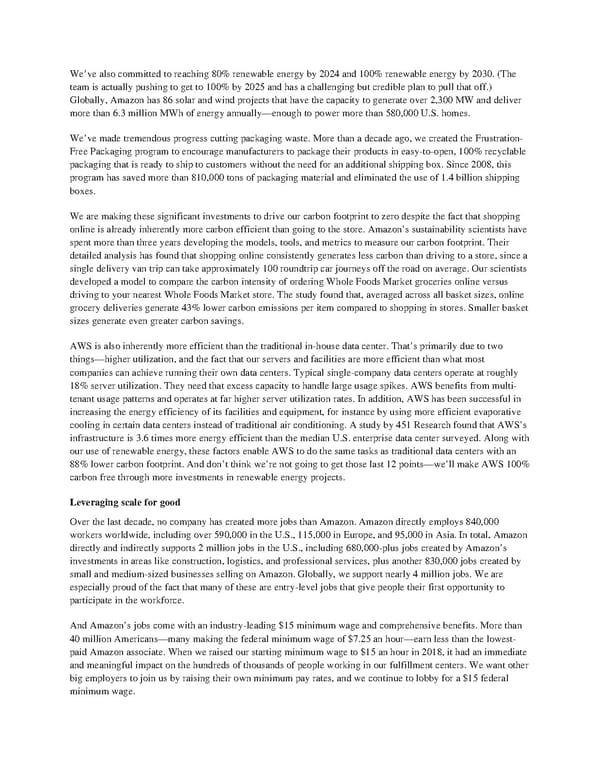We’vealso committed to reaching 80% renewable energy by 2024 and 100% renewable energy by 2030. (The team is actually pushing to get to 100% by 2025 and has a challenging but credible plan to pull that off.) Globally, Amazon has 86 solar and wind projects that have the capacity to generate over 2,300 MW and deliver morethan 6.3 million MWh of energy annually—enough to power more than 580,000 U.S. homes. We’vemadetremendousprogress cutting packaging waste. More than a decade ago, we created the Frustration- Free Packaging program to encourage manufacturers to package their products in easy-to-open, 100% recyclable packaging that is ready to ship to customers without the need for an additional shipping box. Since 2008, this program has saved more than 810,000 tons of packaging material and eliminated the use of 1.4 billion shipping boxes. Wearemakingthesesignificant investments to drive our carbon footprint to zero despite the fact that shopping online is already inherently more carbon efficient than going to the store. Amazon’s sustainability scientists have spent more than three years developing the models, tools, and metrics to measure our carbon footprint. Their detailed analysis has found that shopping online consistently generates less carbon than driving to a store, since a single delivery van trip can take approximately 100 roundtrip car journeys off the road on average. Our scientists developed a model to compare the carbon intensity of ordering Whole Foods Market groceries online versus driving to your nearest Whole Foods Market store. The study found that, averaged across all basket sizes, online grocery deliveries generate 43% lower carbon emissions per item compared to shopping in stores. Smaller basket sizes generate even greater carbon savings. AWSisalsoinherently more efficient than the traditional in-house data center. That’s primarily due to two things—higher utilization, and the fact that our servers and facilities are more efficient than what most companies can achieve running their own data centers. Typical single-company data centers operate at roughly 18%server utilization. They need that excess capacity to handle large usage spikes. AWS benefits from multi- tenant usage patterns and operates at far higher server utilization rates. In addition, AWS has been successful in increasing the energy efficiency of its facilities and equipment, for instance by using more efficient evaporative cooling in certain data centers instead of traditional air conditioning. A study by 451 Research found that AWS’s infrastructure is 3.6 times more energy efficient than the median U.S. enterprise data center surveyed. Along with our use of renewable energy, these factors enable AWS to do the same tasks as traditional data centers with an 88%lowercarbonfootprint. And don’t think we’re not going to get those last 12 points—we’ll make AWS 100% carbon free through more investments in renewable energy projects. Leveraging scale for good Over the last decade, no company has created more jobs than Amazon. Amazon directly employs 840,000 workers worldwide, including over 590,000 in the U.S., 115,000 in Europe, and 95,000 in Asia. In total, Amazon directly and indirectly supports 2 million jobs in the U.S., including 680,000-plus jobs created by Amazon’s investments in areas like construction, logistics, and professional services, plus another 830,000 jobs created by small and medium-sized businesses selling on Amazon. Globally, we support nearly 4 million jobs. We are especially proud of the fact that many of these are entry-level jobs that give people their first opportunity to participate in the workforce. AndAmazon’sjobscomewithanindustry-leading $15 minimum wage and comprehensive benefits. More than 40 million Americans—many making the federal minimum wage of $7.25 an hour—earn less than the lowest- paid Amazon associate. When we raised our starting minimum wage to $15 an hour in 2018, it had an immediate and meaningful impact on the hundreds of thousands of people working in our fulfillment centers. We want other big employers to join us by raising their own minimum pay rates, and we continue to lobby for a $15 federal minimumwage.
 Amazon Shareholder Letters 1997-2020 Page 102 Page 104
Amazon Shareholder Letters 1997-2020 Page 102 Page 104